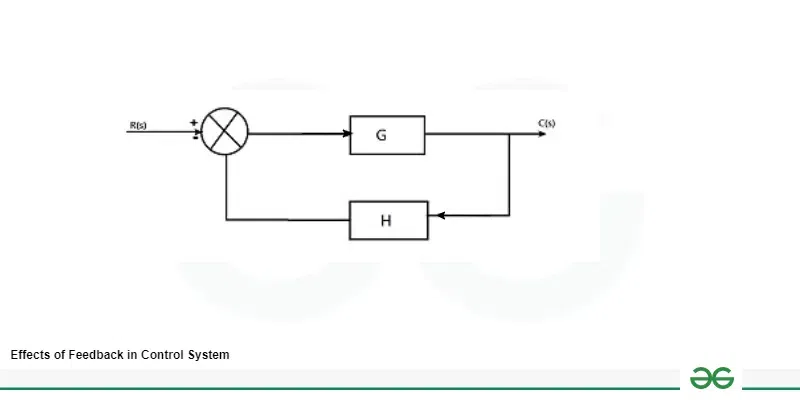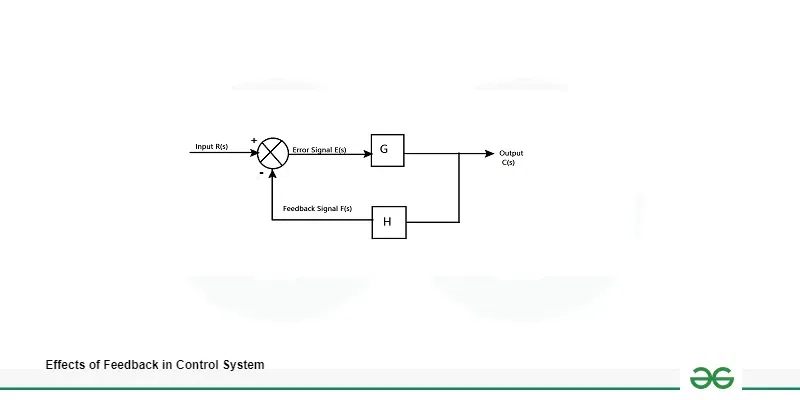Feedback is an important concept in electronics and electrical engineering. It is used to reduce the error between the reference input and the system output. The reduction of system error is merely one of the many important effects that feedback may have on a system. Feedback also affects the performance of features such as security, bandwidth, gain, impact, and sensitivity. Feedback plays an important role in improving the performance of the control systems. In this article, we will take a closer look at the importance and impact of feedback in management.
What is Feedback in Control System ?
Feedback is an important concept in engineering management and plays an important role in monitoring and controlling desired behaviour in many processes and devices. Feedback is a process of collecting information about the system output and using this information to adjust the output, thus creating a closed-loop control system. This loop provides continuous monitoring and control to ensure the system operates within limits and achieves its intended objectives.
Next, we will discuss components of feedback which contain:
- Reference Input /Command Input
- Input
- Output
- Feedback Path
- Error Detector
- Controller
Components of Feedback
The feedback control system consists of five basic components:
- Reference Input /Command Input: The input is applied to the whole system is called Reference input.
- Input : This input process transforms the form of the input into the form utilized by the controller.
- Output: This measures the response of the output and transforms it into the form used by the controller.
- Feedback Path: It is the return way to the summing intersection from the output response. It comprises of a feedback component which gives back the output response to the error detector.
- Error Detector: The error detector obtains the calculated signal from output response and be comparable it with the reference input. It gives the error signal by the difference of two signals also known as the actuating signal.
- Controller: It controls the output response depending to the signal received from the error detector.
The return of the output or part of the output to the input side and being used as part of the input to the system is called feedback. Feedback plays an important role in order to improve the performance of the control system.
Types Of Feedback
There are two types of feedback:
- Positive Feedback
- Negative Feedback
Positive Feedback
Good comment; Adds references, R(s) and comments.
.webp)
Positive Feedback
Evaluate changes to the feedback control system accordingly
T = G / 1 – GH
Where,
- T represents the transfer function or the overall gain of positive feedback control systems.
- G represents the open-loop gain, which is a function of frequency.
- H represents the gain of the feedback path, which is a function of frequency.
Negative Feedback
Negative feedback reduces the error between the input data R(s) and the output. Given block diagram shows the negative feedback control systems.

Negative Feedback
Consider the transfer function of Negative Feedback Control System is
T = G / 1 + GH
Where,
- T is the transfer function or overall gain of positive feedback control systems.
- G is the open loop gain, which is function of frequency.
- H is the gain of feedback path which is function of frequency.
Effects of Feedback in Control System
The role of feedback in management is to ensure that the system operates as expected by comparing its output with the expected output and making adjustments accordingly. Feedback allows the system to correct errors, compensate for interruptions, and maintain stability. It enables control systems to better achieve their goals by increasing accuracy, reliability and performance. Feedback is essential for energy management to work well and increase its effectiveness.
Effects of Feedback in Control System is measured by the factors like :
- Gain
- Stability
- Sensitivity
- Noise
1. Effect of Feedback on Overall Gain
Given Below is the Block Diagram of Effect of Feedback on Overall Gain

Effect of Feedback on Overall Gain
Feedback affects the Gain G of a non-feedback system by a factor 1/( 1 GH). The system is said to have negative feedback, since a disadvantage sign is assigned to the feedback signal. The volume GH may itself include a negative feedback, since a disadvantage sign is assigned to the feedback signal. The volume GH may itself include a negative sign, so the general effect of feedback is that it may increase or drop the gain. In a practical control system, G and H are functions of frequency, so the magnitude of( 1 GH) may be lesser than 1 in one frequency range but lower than 1 in another. thus, feedback could increase the system gain in one frequency range but drop it in another. So Transfer Function with Feedback is
T( s) = C( s)/ R( s) = G/ 1 GH
So Effect can be studied from Transfer Function
- If H is adding also 1+ GH will get increase so Transfer Function will drop.
- If H is dwindling also 1+ GH will get drop so Transfer Function will increase.
- So by changing H, we can change Transfer Function.
2. Effect of Feedback on Stability
Given Below is the Block Diagram of Effect of Feedback on Stability

Effect of Feedback on Stability
A system is said to be stable, if its output is under control, Otherwise it is said to be unstable.
Stability is a notion that describes, whether the system will be able to follow the input command or be used in general. In loose terms, if the System is out of control then it is called unstable.
Referring equation:
M = G / 1 + GH
If GH = -1 the output of the system is infinite for any finite input and the system is said to be unstable.
3. Effect of Feedback on Sensitivity
Given Below is the Block Diagram of Effect of Feedback on Sensitivity

Effect of Feedback on Sensitivity
Sensitivity often are important in the design of control systems. Generally speaking, a good control system should be responsive to changes, but also responsive to commands. Let us investigate what effect of feedback has on the sensitivity to parameter variations.
So the Transfer Function with feedback is:
T(s) = C(s) / R(s) = G / 1 + GH
Sensitivity is defined as percentage change in transfer function to percentage change in gain of the system.
S = %change in T(s) / %change in G(s)
Here,
T(s) is Transfer Function of the system
G(s) is Gain of the system
SGT = (dT/T *100) / ( dG /G *100)
SGT = dT/dG * G/T
Sensitivity is defined as change in output w.r.t input whereas in terms of function it as defined as change in transfer function w.r.t to change in gain of the system.
So effect can be studied from Transfer Function
- If H is increasing then (1+GH) will get increase so sensitivity(S) will decrease
- If H is decreasing then (1+GH) will get decrease so sensitivity(S) will increase
- So Sensitivity and feedback gain is reciprocal to each other
4. Effect of Feedback on Noise
Given Below id the Block Diagram of Effect of Feedback on Noise

Effect of Feedback on Noise
Feedback reduces the impact of noise and affects physical activity.
In general, Feedback also has effects on performance parameters such as bandwidth, impedance, transient response and frequency response,
- Increases accuracy
- Increases the bandwidth
- Stabilizes the unstable system
C(s)/Td(s)=1/(G(s).H(s))
C(s)=Td(s)/G(s).H(s)
where,
C(s) is the system output
R(s) is the reference input
G(s) is the open-loop gain of the system
H(s) is the feedback of the system
Td(s) is the External noise or disturbance
Now, we can realize the effect of Td(s) on output,
- To decrease the effect of Td(s) on output.
- Increase G(s).H(s) or Increase G(s) or Increase H(s).
Advantages and Disadvantages of Effects of Feedback in Control System
Here, we will see some list of advantages and disadvantages of effects of feedback in control system :
Advantages of Effects of Feedback in Control System
- Many unwanted distractions and noise from outside can be stopped.
- System performance changes due to mitigation.
- The regular error of the system may be small.
- The transient behavior of the process can be easily manipulated.
- Compare the feedback to the situation that needs to be fixed.
Disadvantages of Effects of Feedback in Control System
- The system is complicated by the increased number of components, such as sensors and errors detectors.
- The overall gain of the system is reduced and must be compensated for in the design.
- All improvements to the system are discounted and must be paid for at the time of construction.
- The system may not be stable (it may oscillate or depart greatly from the desired output), even through the comparable open-loop system is stable.
- There must be an error parameter to compare two cases.
- If there is change in an output, it will affect the system input.
Applications of Effects of Feedback in Control System
Here, we will see some list of applications of effects of feedback in control system :
- Manufacturing and Production Processes: For Manufacturing and production processes, Control systems are utilized to enhance production processes in factories and other manufacturing facilities.
- Building and Home Automation: For Automation, Control systems are utilized to manage numerous systems in buildings, such as lighting, air conditioning, and security.
- Transportation Systems: Control systems are utilized to manage numerous features of transportation systems, such as control systems such as traffic ,railway and aircraft signaling.
- Power Generation and Distribution: Control systems are utilized to track and manage power generation and distribution systems, such as power plants control system and electric grids control system.
- Medical Equipment: Control systems are utilized to self-operate and manage numerous varieties of medical equipment, such as control system with dialysis machines, and X-ray machines.
- Agricultural and Farming: Control systems are utilized to self-operate and improve numerous farming and agricultural processes, such as fertilization, and crop harvesting.
- Military and Defense Systems: Control systems are utilized to self-operate and control numerous military and defense systems, such as missile defense systems, drones, etc.
- Robotics: Control systems are utilized to design, manage, and control the motion and behavior of robots.
Conclusion
Feedback is a fundamental component of control systems. They help to maintain system stability, improves accuracy by removing the error by comparing the desired output with the actual output. Feedback is used in every aspects like robots, airplanes, cars, medical equipment, home comfort or communications, the feedback system ensures everything goes right. They are important in the world of technology and engineering because they help things run better and more reliably.
Effects of Feedback in Control System – FAQs
What are the benefits of using feedback in management?
In a closed loop system by using feedback we can control the controller output to reduce error. By using this the accuracy of the system is maintained.
Why is feedback important for stability in control systems?
Feedback in control system maintains the stability and accuracy of the system. In this the output is adjust based on actual performance.
How do engineers design feedback control systems?
They use math and special rules to figure out how to make systems work well, choosing the right tools and testing things out.
What challenges do feedback control systems face?
It may be tricky for complex systems.
Share your thoughts in the comments
Please Login to comment...